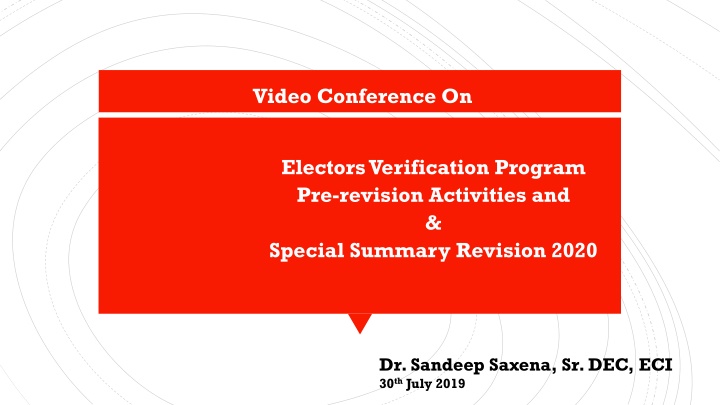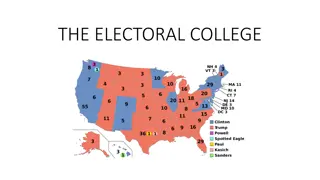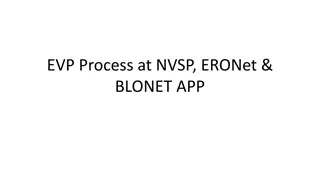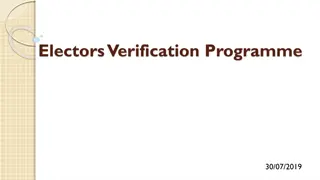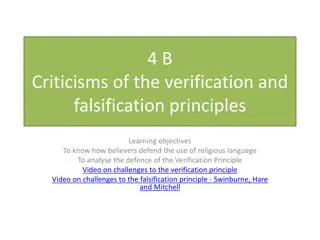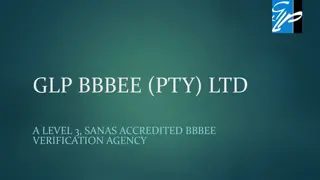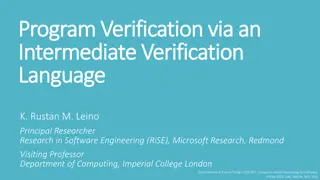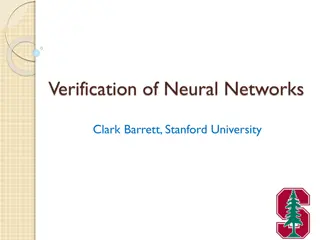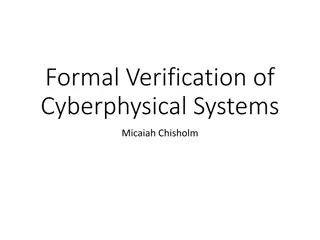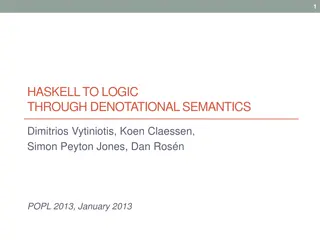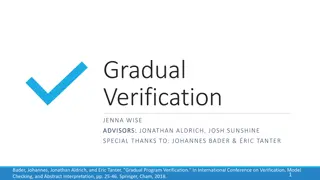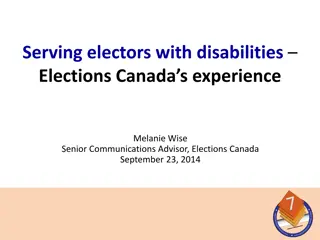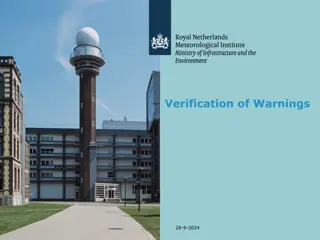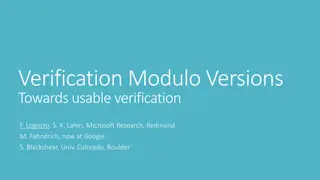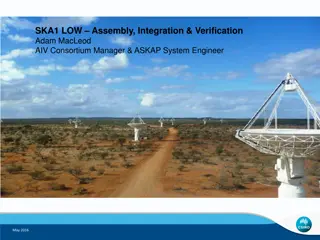Electors Verification Program and Special Summary Revision Activities
The Electors Verification Program (EVP) aims to encourage citizens to authenticate their electoral details through various methods like mobile apps, portals, and Common Service Centers. The program includes verifying existing entries, collecting family information, enrolling unenrolled citizens, and addressing discrepancies. House-to-house verification by BLOs ensures 100% information collection, including correcting entries, family tagging, enrolling citizens, and removing errors. Pre-revision activities involve standardizing data, verifying contact details, and preparing improved maps of polling stations.
Download Presentation

Please find below an Image/Link to download the presentation.
The content on the website is provided AS IS for your information and personal use only. It may not be sold, licensed, or shared on other websites without obtaining consent from the author.If you encounter any issues during the download, it is possible that the publisher has removed the file from their server.
You are allowed to download the files provided on this website for personal or commercial use, subject to the condition that they are used lawfully. All files are the property of their respective owners.
The content on the website is provided AS IS for your information and personal use only. It may not be sold, licensed, or shared on other websites without obtaining consent from the author.
E N D
Presentation Transcript
Video Conference On Electors Verification Program Pre-revision Activities and & Special Summary Revision 2020 Dr. Sandeep Saxena, Sr. DEC, ECI 30th July 2019
Electors Verification Programme (EVP)- 01.08.2019 to 31.08.2019 Citizens to be encouraged to authenticate existing elector s details including Mobile Nos./e- mail ids, by giving copy of one of the following documents:- 1.Indian Passport 2.Driving License, or 3.Aadhaar 4.Ration card 5.Identity Card for Government/Semi-Government officials. 6.Bank Passbooks 7.Farmer s Identity Card 8.Any other document as approved by the Commission. Information on Family Members Details of Un-enrolled /Dead/Shifted electors/ Prospective Electors in the Family Information about Polling Station Geo Tagging the House (with Mobile App.)
Electors Verification Programme (EVP)- 01.08.2019 to 31.08.2019 The citizens to verify their electoral details and give Family information through :- 1. Voter helpline Mobile app, 2. NVSP portal, 3. By visiting Common Service Centers (CSCs) etc. 4. 1950 Voter Helpline. On filling up the information:- a. If any discrepancy is reported in the elector s detail, automatic Form 8 will be generated b. In case of Dead/shifted members, facility of generation of Form-7 would be provided. Form-7 would be filled by a near relative/family member c. For registration of un-enrolled eligible elector will be given facility of filling up of Form - 6. d. Details of prospective voters will be collected during the programme for keeping the same in database and eventual submission of Form-6 once SSR 2020 period starts. e. PWD electors will be given facility through Voter helpline No. 1950 to give their details.
Electors Verification Programme (EVP)- 01.09.2019 to 30.09.2019 House to house verification and collecting 100% information by BLOs:- a. To verify the information/details collected from citizen through crowd sourcing. b. BLOs would also collect information/details of Not covered 1. Verification and Correction of Existing entries including Mobile Nos./ email ids 2. Family Tagging- with relationship 3. Enrolling all unenrolled citizens, 4. Collecting prospective Electors details 5. Removal of Multiple Entries/DSE, Dead and Shifted Electors. 6. Removal of Logical Errors 7. Flagging of PwD and Marked Electors 8. Probable Polling Station Buildings
Pre Revision Activities- 01.08.2019 to 15.09.2019 1. Verification and Correction of Existing entries All Photos to be as per ECI Specification 2. Collecting and verifying Mobile Nos./ e-mail ids 3. Family Tagging- (Electors living together with relationship matrix) 4. Enrolling all unenrolled citizens, 5. Collecting prospective Electors details- (Born on or before 1.1.2021 i.e. +17, +16 yrs.) 6. Removal of Multiple Entries/DSE, Dead and Shifted Electors. 7. Removal of Logical Errors- No Non Standard/repeat EPIC Nos. 8. Standardization of addresses of Electors and Sections 9. Recasting of Section (Capturing GPS Location) 10.Optimizing Part Boundaries 11.Preparation of Improved Maps of Part 12.Assessing the Facilities of existing PS/ Mapping alternate PS Building Approval of Commission-16.09.2019(Monday) to 15.10.2019(Tuesday)
Pre Revision Activities- Role and Responsibilities with time line 1. Verification and Correction of Existing entries with Photos to Specification 2. Providing/ collecting and verifying Mobile Nos./ e-mail ids 3. Family Tagging- (Electors living together with relationship matrix) 4. Enrolling all unenrolled citizens, 5. Collecting prospective Electors details- (Born on or before 1.1.2021 i.e. +17, +16 yrs.) 6. Reporting of Multiple Entries, Dead and Shifted Electors, Marking PwDs. 7. Polling Station details/ Alternate Probable Polling Station Buildings Electors Voter Helpline App, NVSP, CSCs/VFCs, 1950- (01/08/19-30/09/2019) BLO (Campus Ambassadors/Volunteers)- BLO Mobile APP- (01/09/19-30/9/2019) Verification of details uploaded and capturing and verification of non covered citizens. Campus Ambassadors/BAGs/RWAs/Volunteers-??????
Pre Revision Activities- Role and Responsibilities with time line 1. Removal of DSE/ ISE-??/Logical Errors 2. Flagging of PwD and Marked Electors ERO- ERO Net- 01/08/2019- 31/08/2019 BLO Field verification- BLO App 01/09/2019- 30/09/2019 3. Standardization of addresses of Electors and Sections 4. Recasting of Section (Capturing GPS Location) 5. Optimizing Part Boundaries 6. Preparation of Improved Maps of Part (GIS on Revenue Map, Satellite Imagery) AERO/ Election incharge- ERO Net -01/08/2019- 31/08/2019 Assisted by BLO/BLO Supervisor/field staff of Local bodies/Survey/Local Planning Dept./ Postman-???? 7. Assessing the Facilities of existing PS including accessibility/Mapping alternate PS Building AERO/ERO Field verification- BLO App 01/09/2019- 30/09/2019
Preparatory Activities District Election Officer concerned in the leadership of CEO, will authorize Common Service Centres (CSCs)/similar Centres to provide electoral services by 31.07.2019 in a drive mode. The CEOs shall conduct meetings through video conference with the DEOs, EROs and Roll Observers to brief them about the schedule and activities of SSR, 2020, in detail. The CEOs shall formulate and execute an effective SVEEP campaign at the state, district and assembly constituency level. Meeting with the Political Parties to be convened by CEOs and DEOs to inform them of the EVP and soliciting their cooperation. DEOs to mobilize support staff from sister departments for PS verification and GIS work BAG members, Campus Ambassadors and RWAs to be sensitized and involved. Activating 1950 district helpline centers
Improved Nazari Naksha 1. Nazari Naksha (Street name with Section Marking) with names of street, landmarks, House no. and No. of buildings 2. Google Map View showing part boundary Map 3. Polling Station Premise Front View 4. Polling Station Building Front View 5. CAD View (indicating arrangements within the polling booth) 6. Key Map View (with the indication of how to reach) Nazari Naksha and Part boundary maps can be prepared in following ways: a) Map of City/Town/Village be taken from respective digital Revenue/ Land Record/Planning department and parts are marked on it by hand or Satellite Imagery Map may be super imposed and part boundaries are drawn using a GIS Tool b) Notional Part Boundary may be prepared using IT application. In this a mobile device is used and coordinates are captured by moving around the part. c) ECI IT team will issue detailed guidelines separately
Section boundary identification can be done in following ways after preparation of part boundary: a) Street and building Map of the part is prepared and marking of houses is done with house number. If house number is not there then a notional house number is given. Then sections are created by grouping the electors based on house number. After creation of section it s naming is done. b) Satellite view of the part is taken and superimposed on part boundary map. Then habitation is marked by hand and sections are created by grouping the electors based on house number. If house number is not there then a notional house number is given. After creation of section it s naming is done. Existing Polling Station is marked on the map by capturing its coordinates using mobile device. Elector s feedback about any natural barrier etc. and Information about probable Polling Station can be considered Status of Assured Minimum Facilities (AMFs) and additional facilities at the polling stations will be captured with the photograph of Polling Stations. This exercise is to be completed by 31st August, 2019.
Optimization of Polling Stations and Standardization of sections: 100 % physical verification/inspection of the Polling Stations and capturing its longitude and latitude. For accessibility all PS to be on ground Floor. Latitude and Longitude of all Polling Stations, newly identified probable/ proposed for creation/change of location of Polling Stations shall be captured and details of the same shall be updated in the ERO-Net Dashboard. Regularization of auxiliary polling stations created during Lok Sabha Election, 2019. Change in location of polling stations situated in damaged buildings. Proposal on change of location shall be sent to the Commission only after Removal of ghost polling stations (polling stations with nil electors). All the polling stations with electors beyond 1500 be rationalized/modified as per the given schedule and before the draft publication of electoral rolls in accordance with instructions contained in Manual on Polling Station, 2016.
The Commission has been very concerned about wrongful deletion of names of electors of electoral roll. No deletion to be made without serving notice. All the notices for deletions/ hearings served to the concerned electors and proceedings of the same to be uploaded on the ERO net. Other objectives of rationalization of polling stations are to group all the family members and neighbors in a section and maintain uniformity of addresses in ER and EPICs. For proper formation of Sections the following units may be formed: a. Nuclear/Immediate family (Husband, Wife and eligible children) b. Joint Family/Household (Group of several nuclear families related to each other and living at the same place) c. Door /Flat No. d. Building/Block/Tower consisting of a no. of doors/flats. e. Street
Standardization of addresses To standardize the address of electors the following fields of addresses shall be maintained while preparing the roll:- a) House No./ Flat No./Door No. (Name of house, if available)* b) Floor No. (in case of multi-story building) c) Building No./Block No./ Tower No. ( name of building, if available) d) Apartment No. e) Wing f) Ward No.* g) Street/ Road/Lane* h) Sector i) Area/Locality* j) Landmark, if any k) Post Office l) Village/Town/City* m) Local Body Name (Panchayat/ Municipality/ Corporation )* n) Sub-district/Tehsil o) District* p) State* q) Pin code* The fields marked with (*) should be mandatorily mentioned in the electors details, while the remaining fields may be taken as optional fields and be included wherever necessary (like in urban areas).
The CEO/DEO may include the other fields in the mandatory category as prevalent in the State/District. Where no House no. as given by the Panchayat/ Municipal Authorities is available, the notional number will be given in the roll. The electors will be arranged in the roll in sequence, according to the House no. (and Floor no. of the building). While creating a new polling station or re-organizing the existing polling stations by creating/merging/ attaching sections to the adjacent polling stations, the fulfillment of following conditions should be ensured: 1.No family is broken and all the family members are kept in the same section and at the same place, 2. Electors residing in a building are enrolled in the same part, 3. As far as possible electors residing in a Street are enrolled in the same part, and 4. The electors of so merged/attached polling station are not required to travel for more than two Kilometer distance and to cross any natural barriers.
Sl. Activity Period No. 1. 15.10.2019 (Tuesday) Publication of Integrated draft electoral roll 2. 15.10.2019 (Tuesday) to Period for filing claims & objections 30.11.2019(Saturday) 02.11.2019 (Saturday) & 3. Special campaign dates 03.11.2019 (Sunday) 09.11.2019 (Saturday) & 10.11.2019 (Sunday) By 25.12.2019(Wednesday) 4. Checking of health parameters and obtaining Commission s permission for final publication Updating database and printing of supplements 5. By 31.12.2019(Tuesday) 6. 01.01.2020(Wednesday) to Final publication of electoral roll 15.01.2020 (Wednesday) as decided by the Commission.
Draft Publication: Before draft publication of electoral roll, the CEO shall take prior written clearance of the Commission for draft publication of the electoral rolls and Draft publication will be done only after completion of all activities relating to removal of logical errors, 100% coverage of photographs as per Specification and removal of non-standard EPIC and EPIC series are to be completed. Integrated Mother Roll to be: 1. Free from any erroneous entry- 100 images as per Specification & Standard EPIC No. 2. All family members together, 3. Families living in a building and adjacent houses coming in sequence 4. No Dead/ shifted Elector, 5. No unenrolled citizen, 6. No DSE/ISE-??? or Logical Error, 7. Standardization of address of Sections and Part, 8. Improved Nazari Naksha, 9. AMF details with Photos.
Display of list of claims and objections As per rule 16 of the Registration of Electors Rules, 1960, ERO shall prepare lists of claims and objections in form 9,10,11 and 11A and exhibit one copy of such lists on a notice board in the his office. Besides, list of all claims and objections received should be put up on the website of CEO so that citizens are able to see the list and lodge objections with the concerned ERO. In addition to this adequate publicity should be given by CEO to the fact that list of claims and objections is available on his/her website and objections can be raised before the EROs based on this list. This should also be informed to the political parties by holding meetings with them and sending written communication to them. List of claims and objections should be made available by ERO to all political parties on weekly basis. For this purpose, the ERO should call a meeting of all political parties on regular interval and personally handover list of claims and objections to them and obtain acknowledgment. It is to be added that the list should be incremental instead of cumulative. To share above with BLA, AC, Distt representatives of Political Parties if the details are provided on the NVSP portal-???????
Decisions on Claims and Objections Decision on claims and objections should be taken only after all of the following conditions are complied with : (i) At least seven clear days period has passed after list of claims and objections has been published on all of the following a) Website of CEO/ DEO, as clickable lists for each polling station b) Notice board of ERO (In Forms 9, 10, 11 and 11A of RERs 1960) c) Notice board of polling station (In Forms 9, 10, 11 and 11A of RERs 1960) d) A personal notice has been served on the person whose name is proposed to be deleted in cases other than death cases. (ii) claims and objections to political parties. At least period of seven clear days has passed after furnishing the list of
Procedure of Deletion NO SUO MOTO DELETION (Deletion without Form-7) Repeat/Multiple Entries: In repeated / multiple entries reported by individual citizens, BLAs of political parties and RWA representatives, the field verification must be done in each and every case. Name of the elector to be deleted in electoral roll only at the place where he is not found to be ordinarily residing, after receiving Form -7 from the elector himself. Demographically Similar Entries (DSEs), Permanently Shifted and Deceased: (i) Form -7 is received from the elector (incase of DSEs, Permanently Shifted) and near relative/family member (in case of deceased). Notice must be served to the concerned person for removing the entries. Confirmed cases of DSEs, Permanently Shifted and Deceased may be removed only after (ii) names of electors shall be given in a local daily newspaper. Action for deletion of such names should be taken only after expiry of 7 days from the date of publication of notice in the said local daily and on the basis of response on notice, if any, received from persons concerned. The Commission has directed that in all cases of deletion, notice of proposed deletion of
Safeguards against wrongful deletions Following safeguards will be used to prevent wrongful deletions of electors from electoral roll:- i. In case of registered death, deletion shall be made only after proper verification/production of death certificate etc. ii. Provision in ERO-Net will be made available wherein all the orders of deletions passed by the AEROs/EROs shall be verified by the Dy. DEOs/ DEOs before making it available in public domain and to give effect in electoral rolls. iii. To avoid wrongful deletions, deletions on the ground of death and shifting will be made only when Form- 7 is received. iv. While making field verification, BLOs shall give specific remarks in report on the status of shifting/death as the case may be. v. For deletion on the ground on shifting, either Form- 6 or Form- 7 from the concerned elector will be taken. Before addition at new place, the ERO will confirm that the elector was actually enrolled at the previous address and he bears the same name as given in Form- 6. vi. BLO report will be necessary for deletion.
vii. In all cases of proposed deletions through Form-7, notice except death cases must be issued to the elector concerned and must be duly served on him. In cases where the elector is not found living at the address in the electoral roll due service of notice must be done by affixation on the wall in the presence of at least two witnesses whose signatures should be obtained on a copy of notice and kept in the file by the Electoral Registration Officer so as to ensure that provisions of rule 21A of the Registration of Electors Rules, 1960 for giving reasonable opportunity of hearing to the person concerned are duly complied with. Only in the case of death, a death certificate or statement of relatives, friends or neighbours can be accepted in lieu of the proof of due service of notice. viii.All deletions except those done on the ground of death should be verified by an officer not below the rank of Tehsildar/Deputy Tehsildar before final order is passed on Form 7 and 10% of total deletion(randomly picked by system) should be verified by field visits. ix. All cases of deletions must be cross verified personally by Electoral Registration Officer if they fall in any of the following category:- a) Deletions in polling stations where the number of deletions exceed 2% of the total electors in the voters list of the polling stations. b) Deletions where the same person is the objector in more than 5 cases. x. Cases of deletions other than those made on the ground of death should be cross verified by BLO Supervisors, AEROs and EROs before passing the orders.
Supervision and Checks by BLO Supervisor/AEROs/ERO There is a mechanism for supervision and check for enforcing strict accountability of the work performed by the Booth Level Officers. The BLO Supervisor who normally has 10 Booth Level Officers under his charge shall verify 5% of each of the Booth Level Officer s verification work under him. Assistant Electoral Registration Officer shall field check households with more than 10 electors; abnormal gender ratio, and the first 20 polling stations with highest number of additions or deletions, under his charge. Assistant Electoral Registration Officer should also separately field check 1% of the additions and deletions, giving focus on such part of electoral rolls where proposed addition of electors is 4% over previous electoral roll. Both, accepted as well as rejected cases, should also be checked in those cases. Electoral Registration Officer shall test check the quality of disposal of claims & objections by his Assistant Electoral Registration Officers. He shall check 10% of the Forms disposed by Assistant Electoral Registration Officers.
Super-checking by Dy. DEO/DEO/ Roll Observer/CEO DEO, Roll Observes and CEO for specific number of entries as randomly selected by ERO-Net. After passing the orders by AERO/ERO, super-checking of verified entries will be done by the Dy. DEO, The number of entries to be verified by Dy. DEO, DEO, Roll Observes and CEO are as under:- I. Verification of 100 entries (40 additions+ 40 deletions + 20 modifications) in the District by Dy. DEO. Out of these 100 entries, field verification must be done in a minimum 10 entries. The entries to be verified by the Dy. DEO by table top exercise as well as field verification will invariably include the entries already verified by Supervisors, AERO and ERO. II. Verification of 50 entries (20 additions+ 20 deletions + 10 modifications) in the District byDEO. Out of these 50 entries, field verification must be done in a minimum 5 entries. The entries to be verified by the DEO by table top exercise as well as field verification will invariably include the entries already verified by AERO, ERO and Dy. DEO. III. Verification of 50 entries each (20 additions+ 20 deletions + 10 modifications) in the assigned Districts by Roll Observer. Out of these 50 entries, field verification must be done in a minimum 5 entries.The entries to be verified by the Roll observer by table top exercise as well as field verification will invariably include the entries already verified by AERO, ERO, Dy. DEO and DEO. IV. Verification of 500 entries (200 additions+ 200 deletions + 100 modifications) in the state by the CEO. Out of these 500 entries, field verification must be done in a minimum 25 entries. The entries to be verified by the CEO by table top exercise as well as field verification will invariably include the entries already verified by Dy. DEO, DEO and Roll Observer.
Flagging of marked electors viz. Public Representatives :MP/MLA/MLC etc., holders of declared offices and personalities from fields of arts, culture, journalism, sports, members of judiciary and public services etc. will be done in the electoral roll. Flagging of Persons with Disabilities (PwDs), who are to disclose their disabilities, will be done in Electoral Database. The CEO shall monitor and verify the reporting made by EROs/DEOs on ERO-Net. In addition to Divisional Commissioners, who shall act as Electoral Roll Observers for districts comprised within their Divisions, the Commission may depute its observers/ECI officers/roll auditors to randomly check, audit and supervise the revision process. All DEOs and CEO shall separately call meetings of political parties and explain the schedule and seek cooperation expected of them before the date of draft publication. In order to bringing more transparency in the process of electoral registration, the practice of computerization and posting of all application forms received in Forms 6, 6A, 7, 8 and 8A on the website of the CEO on a day to day basis, shall. Adequate publicity and awareness drive shall be ensured by DEOs and CEO regarding the summary revision programme.
Integration of roll Detailed instructions on integration, carrying out corrections and printing of electoral rolls have been issued vide the Commission s letters dated 25th September, 2018 and 14th February, 2019 and the same shall be scrupulously followed during the current round of revision also. The printing of electoral rolls henceforth shall be done only through ERO-Net. So far as the integration of electoral roll is concerned, it is clarified that:- i. At the time of draft publication to publish mother roll for SSR, 2020, the mother roll (draft roll) of SSR-2019, plus 3 supplements prepared during revision and continuous updation thereafter will be integrated and amalgamated by bringing family members together. ii. At the time of final publication of SSR, 2020, the final roll will be a single integrated one, in which all the addition entries will come with Sl. No. in continuation after the last entry of the mother roll and all the modifications and deletions during summary revision will be reflected in the mother roll itself, as per the Commission s existing instructions. No separate addition, deletion and modification lists will be printed.
The Commissions approval for Final Publication (i) publication of the electoral rolls and for that purpose a certificate, to the effect that all the cases of dead/DSEs/Shifted/Registered death and un- enrolled electors have been taken into account and disposed of by the ERO concerned, all logical errors have been removed and 100% EPIC and 100% coverage of photographs in Photo Electoral Rolls have been achieved, shall be submitted by the CEO. The CEO shall take prior written clearance of the Commission for final (ii) Request for final publication shall be made to the Commission by the Chief Electoral Officer along with Formats 1-8 by 25th December, 2019. It is clarified that Formats 1 to 8 will be generated through ERO-Net. For this, the data of age-cohort wise projected population, entered during the SSR, 2019 shall be updated by the DEOs immediately.
Suggestions/ Comments of CEOs are solicited on.. Suggestions/ Comments of CEOs are solicited on .. Strategy for Sensitization and Motivation of Stakeholders for EVP and SSR 2020 Cascaded training and capacity building of Staff for EVP and SSR 2020 The proposed EVP, Pre-revision and Revision Schedule and activities. List of documents for verification. Whether document no. be kept in database. To provide facilities for appointing the BLA, AC/Distt./State representatives of Political Parties and sharing of information on ER Operations periodically on NVSP. On the standardization of Section and part boundaries Preparation of Improved Nazari Naksha with six Images Involvement of CSCs and similar Voter facilitation centers Geo Tagging and GIS activities Activating BLOs and optimization of BLO activities. Integrated Common Rolls for AC Constituencies/ Local Bodies Constituencies. ERO Net: Improved Dashboard, time limits, escalation of time barred cases
Expected outcome of EVP For Electoral Officers; 1. Error free electoral rolls. 2. No. of Form 8 would be reduced. 3. Data entry work and resultant errors would be reduced. 4. Encouraging online submission and processing of electoral forms 5. Standardization and Portability of EPIC No.- simultaneous deletion and addition with no repeat entries in system. Log record of all ER operations. 6. No Dead/Shifted Electors/ repeat entries in the Roll 7. Periodical/ regular updation of Electoral Rolls possible. 8. Constant connect with the existing Electors through Mobile App, SMS, e-mails. 9. Prospective electors can be connected through existing electors in family for their enrolment when become eligible. 10.Complete data of PwD for accessible elections. 11.GIS in ER may help in correcting the Sections and Part boundaries through a GIS based decision support system. 12.Linking with Birth and Death register would enable capturing data on dead electors and prospective electors. 13. Help in optimizing the BLO system. 14.Reduction in workload related to Registration work. 15.It is possible to generate Common integrated ERs for Local bodies.
Expected outcome of EVP For Electors/ Citizens- 1. Error free entry electoral rolls. 2. Historical information on what ER operations have been done for Electors entry would be available. 3. Ease of submitting their registration 4. Portability of EPIC No. 5. No unenrolled family member. 6. No deletion of name without information to Elector. 7. Periodical/ regular notifications on updation of Sl. No. and Part No. in Electoral Rolls. 8. Constant connect and Update with the Electoral Officers and Returning Officers through Mobile App, SMS, e-mails for various important changes and notifications. 9. Prospective electors can be connected through existing electors in family for their enrolment when eligible. 10.GIS in ER may help in knowing how to reach your Polling Station and Know your polling station .
Expected outcome of EVP For Political Parties:- 1. Effective participation and transparency in enrolment and E Registration Operations. 2. Error free entry in electoral rolls. 3. Constant flow of information on the ER operations. 4. Notifications on the changes done/proposed in ER No 5. Periodical/ regular updation of Sl. No. and Part No. in Electoral Rolls. 6. Constant connect and Update with the Electoral Officers and Returning Officers through Mobile App, SMS, e-mails. 7. Prospective electors can be connected through electors in family for their enrolment when eligible. 8. GIS in ER may help in knowing how to reach your Polling Station and Know your polling station .
